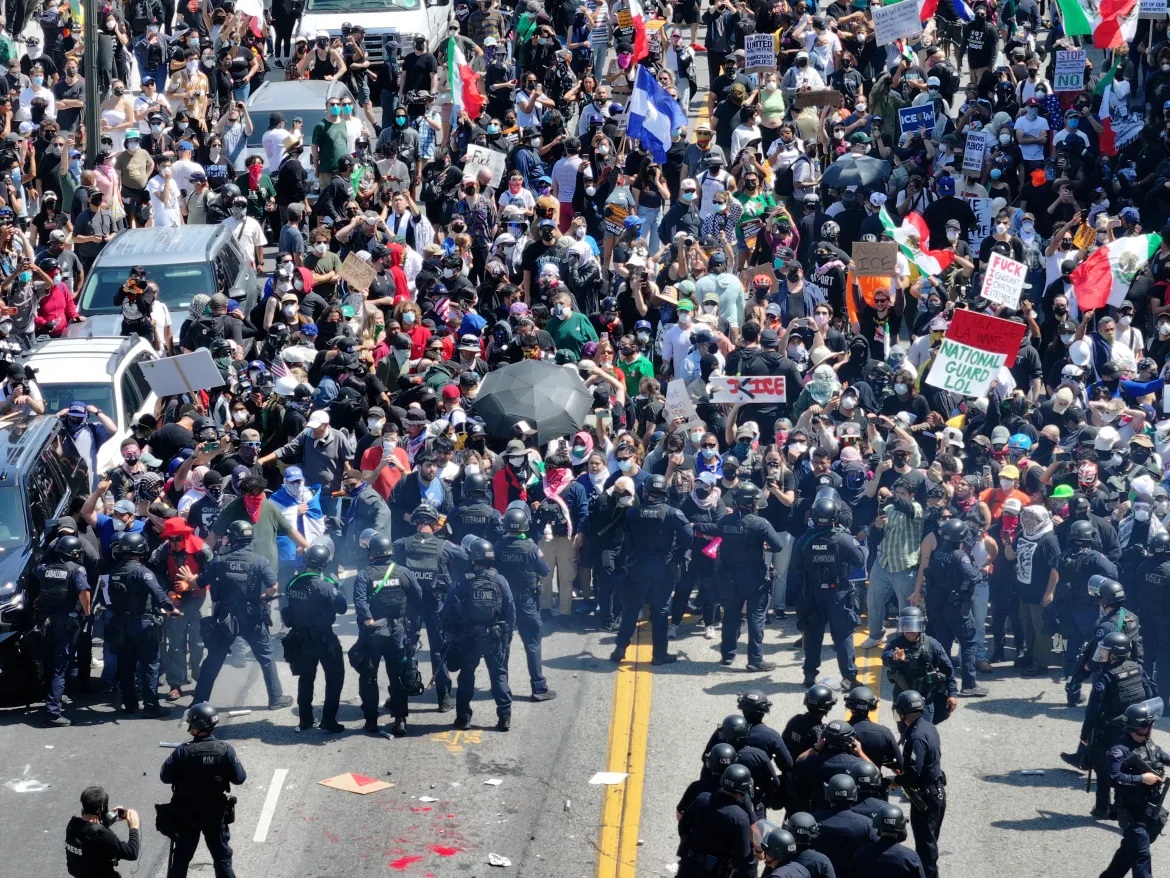Los Angeles became a battleground on June 6, 2025, not just between protesters and federal agents, but between two visions of government power.
What began as a series of controversial immigration raids quickly escalated into one of the most politically and constitutionally explosive moments in recent U.S. history.
Within days, peaceful protests over ICE actions turned into citywide unrest, prompting President Trump to deploy thousands of federal troops to the streets of LA, without the consent of California’s governor.
The move ignited legal challenges, divided the nation, and drew fierce resistance from state leaders, civil rights groups, and everyday residents.
At the heart of the crisis lies a deeper question: Who gets to control the balance between order and liberty in a democracy under stress?
Overview of Events
In early June 2025, Los Angeles became the epicenter of a rapidly escalating conflict between federal immigration authorities and state and local governments.
The flashpoint was a series of aggressive U.S. Immigration and Customs Enforcement (ICE) raids launched on June 6 in Latino-majority neighborhoods and commercial zone.
These include the Fashion District and Home Depot parking lots, where federal agents detained dozens of undocumented immigrants.
The raids, which involved the use of flash-bangs and tear gas, triggered an immediate public backlash.
In the hours and days following, protests erupted throughout the city, especially near federal buildings downtown.
Demonstrators, civil rights advocates, and immigrant communities decried what they viewed as an unjust, militarized assault on immigrant families and public spaces.
What began as peaceful demonstrations quickly evolved. By June 7, rallies had spread to Boyle Heights, Paramount, and Compton.
Protest tactics included freeway shutdowns, blockades of ICE vans, and sit-ins near deportation centers.
Some events turned confrontational, prompting the federal government to escalate its response.
Federal Response and Deployment of Troops
In response to the growing protests, President Trump federalized the California National Guard and deployed approximately 4,000 troops, including 700 active-duty Marines, under Title 10 (10 U.S.C. § 12406).
This allowed the federal government to assume command of the state’s National Guard without the consent of California Governor Gavin Newsom, a rare and controversial move that had not been seen since the civil rights era.
While the Insurrection Act was not formally invoked, the administration cited threats to federal property and personnel, particularly ICE agents and federal buildings, as justification for the deployment.
Officials argued that the scale and intensity of protests posed significant security risks, including the potential for violence, sabotage, and obstruction of federal law enforcement operations.
State and Local Opposition
California officials reacted swiftly and strongly. Governor Newsom and Los Angeles Mayor Karen Bass condemned the deployment as unconstitutional and politically motivated.
They argued that the situation did not warrant federal intervention, and that local law enforcement was fully capable of managing the protests.
The state filed a lawsuit (Newsom v. Trump) on June 9, challenging the legality of the deployment on Tenth Amendment and Posse Comitatus Act grounds.
A federal judge initially issued a temporary block, but on June 12, the Ninth Circuit Court of Appeals granted a stay, allowing the deployment to proceed.
A week later, the court upheld the administration’s authority on the grounds of federal interest and security.
The case remains under review and could eventually reach the U.S. Supreme Court.
Legal and Constitutional Questions
The legality of the deployment remains unresolved. Key legal debates include:
Federal Authority vs. State Sovereignty: Critics argue that bypassing state approval violates the foundational principle of federalism.
Use of Military in Civilian Law Enforcement: The Posse Comitatus Act prohibits the use of federal military forces in domestic law enforcement. If National Guard units were used to police protests or enforce immigration laws, it could constitute a violation.
Threshold for Federalization: Legal scholars contend that the situation did not meet the standard for federal intervention—no insurrection or law enforcement collapse had occurred.
Despite temporary court approval, many view the deployment as an overreach that sets a troubling precedent for future federal-state conflicts.
JD Vance’s Defense and Public Backlash
Vice President JD Vance defended the administration’s actions during a visit to Los Angeles on June 20.
He emphasized the need for continued troop presence, citing concerns about renewed unrest and the protection of ICE operations.
Vance labeled the protests as “insurrectionist mobs” and accused local leaders of enabling lawlessness by refusing to support immigration enforcement.
His remarks were met with sharp criticism:
Local Residents and Protesters: Community members described the military presence as excessive and intimidating.
Many emphasized that their protests were peaceful and constitutionally protected.
City Leaders: Mayor Bass called Vance’s statements inflammatory and dangerous.
LAPD officials noted that the federal troops had complicated coordination efforts and were not requested.
Public Opinion: A Reuters/Ipsos poll conducted in mid-June showed 58% of Californians opposed the troop deployment, while only 32% supported it.
Arguments For and Against the Deployment
Supporters Say:
The federal government has the right—and responsibility—to protect its property, personnel, and legal authority.
Federal intelligence indicated real risks of violence and disruption.
Precedents (e.g., Little Rock, 1957) allow the president to federalize troops in crises involving civil unrest.
Opponents Say:
The move violated state rights and democratic norms.
Local agencies were not overwhelmed and did not request help.
The deployment was more political than practical, timed to bolster Trump’s law-and-order image ahead of the 2026 midterms.
Conclusion
The deployment of the National Guard to Los Angeles in June 2025 has become a flashpoint in a broader national debate over immigration enforcement, state sovereignty, and the limits of presidential power.
While the courts have so far allowed the deployment to stand, its long-term legality, and its political fallout, remain uncertain.
Whether seen as a necessary act of federal protection or a dangerous federal overstep, the episode will likely shape the national conversation on civil liberties, protest rights, and the role of military force in domestic affairs for years to come.


